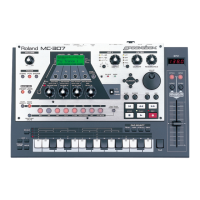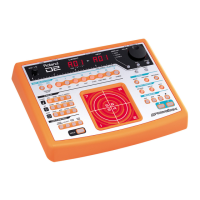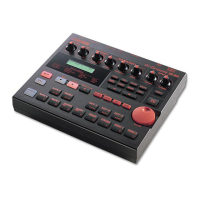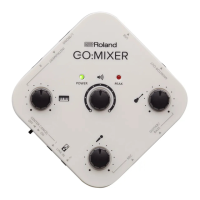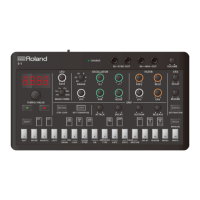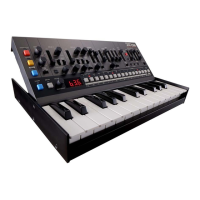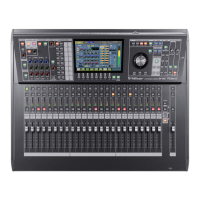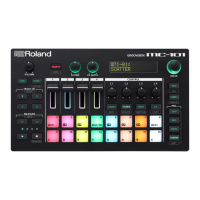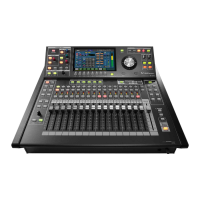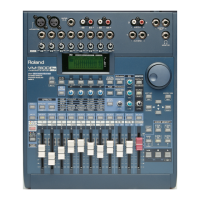41
A tone track is a track that provides PCM/VA synthesis and sample
playback functionality.
Use a tone track when you want to play pitched phrases.
Simple Sound Editing
1.
In the home screen, use the cursor buttons to select the
tone track that you want to edit.
* If the sound source is Clip, select the clip that you want to edit.
2.
Hold down the [SHIFT] button and press the [SOUND]
button.
The TONE EDIT screen appears.
3.
Use the cursor buttons to select an icon, and use the [C1]–
[C4] knobs to edit.
Press the [FUNC] button to access the second page of the editing
items.
CTRL
Here you can make settings related to voicing.
Parameter Value Explanation
OCT
(Octave Shift)
-3–+3
Species the pitch of the tone in octave
units (maximum of ±3 octaves).
VOICE
(Mono/Poly)
MONO, POLY
Species whether the tone plays
polyphonically (POLY) or monophonically
(MONO).
MONO: Only the note of the last-played
key is played, one note at a time.
POLY: Multiple notes can be played
simultaneously.
PORTAMENT
(Portamento Switch)
OFF, ON
Species whether the portamento (*1)
eect is applied (ON) or not applied (OFF).
P.TIME
(Portamento Time)
0–127
Species the time over which the pitch
changes when using portamento. Higher
settings will cause the pitch change to the
next note to take more time.
*1 Portamento is an eect that smoothly changes the pitch from
one key to the next key that you press. Applying portamento
when Mono/Poly is set to “MONO” will produce an eect
reminiscent of the slide performance technique on a violin.
OSC 1–4
Here you can make settings for the oscillators of each partial.
Parameter Value Explanation
OSC
(OSC Type)
OFF, PCM, VA, PCM-
Sync, SuperSAW,
Noise
Species the oscillator type.
PCM: Sound is produced by PCM. This
sounds the wave specied by Wave Group
and Wave Number L/R.
VA: Sound is produced by an analog-
modeled wave generated by calculation.
This sounds the wave of the number
specied by Waveform.
PCM-Sync: Sound is produced by the wave
specied by the PCM-Sync Wave Number.
SuperSAW: Sound is produced by
SuperSAW.
Noise: White noise is produced.
Parameter Value Explanation
GROUP TYPE
(Wave Group Type)
INT, SAMP
INT: When OSC TYPE is PCM, the internal
waveforms of the MC-707 are used.
SAMP: When OSC TYPE is PCM, the
waveforms loaded into the project are
used.
BANK
(Wave Bank) A, B, C
Species the bank (A–C) that is sounded
when OSC Type is INT.
WAVE
(Wave Number L/R)
Species the wave number within the group specied by Wave
Group.
Species the sample number when TYPE is SAMP.
* In EASY MODE, the same waveform is specied for L and R.
FORM
SAW, SQR, TRI, SIN,
RAMP, JUNO, TRI2,
TRI3, SIN2
Species the wave that is sounded when
OSC Type is VA.
SAW: Sawtooth wave
SQR: Square wave
TRI: Triangle wave
SIN: Sine wave
RAMP: Ramp wave
JUNO: Modulated sawtooth wave
TRI2: Triangle wave variation
TRI3: Triangle wave variation
SIN2: Sine wave variation
PW 0–127
This is an eect obtained by varying the
pulse width duty cycle to modify the
waveform.
It is available when OSCType is VA, and also
allows you to create eects with other than
SQR (square wave).
PWM -63–+63
Species the amount (depth) of LFO
applied to PW (pulse width).
LFO follows the settings of LFO2.
OSC (PCM-SYNC)
Parameter Value Explanation
WAVE
(PCM-Sync Wave No.)
Species the wave that sounds when OSC Type is PCM-Sync.
The PCM-Sync oscillator is eective when Structure is SYNC and
set to Slave (the sync-modulated Partial 1, 3).
OSC (SuperSAW)
Parameter Value Explanation
DETUNE
(SuperSAW Detune)
0–127
Species the width of pitch variance
between the seven sawtooth waves that
are layered within one oscillator.
Higher values produce greater pitch
variance. (When doing this, OSC Detune
changes the pitch for each of the seven
sawtooth waves by the same width.)
OSC (common to P2)
Parameter Value Explanation
SW OFF, ON Turns the partial on/o.
COARSE -48–+48
Species the pitch in semitone units
(maximum ±4 octaves).
FINE -50cen–+50cen
Species the pitch in one-cent units
(maximum ±50 cents).
VOL 0–127 Species the volume of the partial.
Editing the TONE Track
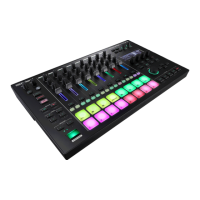
